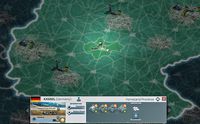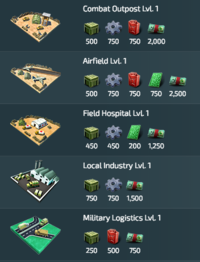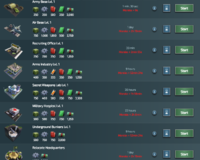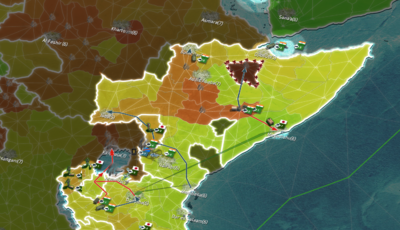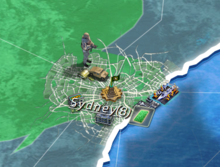Difference between revisions of "Provinces"
From Conflict of Nations Wiki
| Line 46: | Line 46: | ||
<h3>City Nationalization</h3> | <h3>City Nationalization</h3> | ||
<div> | <div> | ||
| + | [[File: NATIONALIZE_ICON_BIG.png|thumb|right|200px]] | ||
Converts a Conquered City into a [[Provinces#Homeland_City|Homeland City]], producing resources and mobilizing units at full capacity. If you have less than 6 cities at game start, you will be allowed to convert any future conquered city up to the limit of 6. If you have more than 6 cities at game start, you will only be able to create Homeland Cities if your current Homeland City count is lower than your initial starting city count. | Converts a Conquered City into a [[Provinces#Homeland_City|Homeland City]], producing resources and mobilizing units at full capacity. If you have less than 6 cities at game start, you will be allowed to convert any future conquered city up to the limit of 6. If you have more than 6 cities at game start, you will only be able to create Homeland Cities if your current Homeland City count is lower than your initial starting city count. | ||
<ul> | <ul> | ||
Revision as of 04:43, 18 January 2019
Contents
Provinces
Provinces are the life of your strategic conquest, and will prove to be useful as outposts, airbases, navy bases and more. They have attributes such as Population, Morale, Production, and Terrain Type.
- Capturing and holding a province adds to your total Victory Points. In order to capture a province, your units must occupy its center-point (the point where roads usually form a junction). Note that only units that have the 'Capture and Occupy' ability will be able to do this, i.e. most infantry excluding Special Forces.
- Some provinces contain resources that you harvest by building Local Industry. These resources spawn randomly when a new game is created.
- Units that are stationed on a province's center-point receive an entrechment bonus that can be further increased through the construction of certain buildings.
- Provinces without cities on their center-point have their own construction list.
Cities
Cities have the largest strategic value as they are worth a lot of Victory Points, which even increase further as a city's population grows.
- Capture a city just like you would any other province. In this case, the city represents the province's center-point.
- Homeland cities and annexed cities are the biggest source for resources.
- Cities provide a better entrechment bonus to defending troops, compared to normal provinces, and have more buildings in their construction list that further increase it.
Homeland City
Homeland cities are cities that you own at the start of a campaign. These cities have the best starting attributes, with high morale and population, so keep a good eye on them.
Occupied City
As you conquer new cities, the local population will not appreciate your invasion into their homeland. The maximum morale cap will be lower compared to annexed and homeland cities, and you will not be able to mobilize units. You can, however, construct buildings.
Annexed City
Annexed cities remove the morale cap of an Occupied City and allow you to start mobilising units. As a result of this increase in Morale, also earns you a higher population rate and better resource gathering.
To Annex a city, select it in your construction list.
City Nationalization
Converts a Conquered City into a Homeland City, producing resources and mobilizing units at full capacity. If you have less than 6 cities at game start, you will be allowed to convert any future conquered city up to the limit of 6. If you have more than 6 cities at game start, you will only be able to create Homeland Cities if your current Homeland City count is lower than your initial starting city count.
- Unlocks mobilization of units in the city
- Increases the city's base resource production to 100%
- takes 9+ hours (depending on morale may be up to 12)
Population
The size of a province's population determines the base production rate of its resources. Buildings that boost economic output base their gains on this rate. Population size also indicates how many Victory Points a province is worth. The greater the population, the greater the number of Victory Points.
- Investment in infrastructure, the construction of bunkers and hospitals, and garrisoned units will gradually increases population morale.
- Wars with multiple nations, poor diplomatic relations, and a lack of basic supplies will have a negative impact.
WMD Contamination
WMD missile attacks will contaminate the target province, which damages unprotected units and population over time. You have to manually decontaminate affected provinces by selecting the contaminated province and selecting the 'Decontaminate' option.
Contamination has a number of effects on the province, including preventing mobilization, preventing population growth and stopping airstrips from being used.
Morale
Morale plays a vital role in your nation's efficiency. It increases/decreases over time and is influenced by several factors. The morale for each province is updated with every in- game day-change. You can gain an overview of your provinces' morale by toggling the Population Morale overlay via the Settings & Info Panel.
- Morale of a province directly affects its resource production rate, unit mobilization times, and construction time of buildings.
- If a province has a low morale level, its output of resources is significantly reduced.
- The most dramatic outcome of low morale is insurgency. In order to counter population uprisings, leave a unit behind to boost morale.
Some factors that affect your population's morale include:
- Availability of Resources - Citizens need certain goods to be efficient members of society. Make sure your population's basic needs are met. These are 'Supplies' and 'Money', should these be in red, or zero - there will be a impact on population morale. [Click on the 'i' button next to Production Per Day on the province bar to view the upkeep of the city.
- Distance to headquarters (or capital)
- War - Nobody likes war. Being at war with too many countries has a significant impact on population morale.
- Morale of neighbouring provinces - A revolutionist mood can spread across province borders, including those of neighbouring countries.
- Enemy armies - If hostile troops invade your territory, it will have a negative impact on your people's morale.
Distance to Headquarters
Your nation's capital is a significant factor for morale across provinces.
- The greater the distance between a province and your capital, the greater the negative impact on that province's morale will be.
- You can construct buildings that boost morale.
- You can designate a new city as your capital.
- If your capital is conquered by another player or rogue faction, all your provinces lose 20% morale, and the global morale cap is knocked down to 40%.
Terrain
Each province has a terrain type which can be seen through the terrain overlay or province bar. There are ten types of terrain that will directly influence your unit's attributes.
Terrain Types
Check out the Terrain Modifiers section to see how terrain affects your units' attributes.
| Terrain Icon | Terrain Type | Description |
|---|---|---|
| Open Ground | A light vegetation which favors mobile warfare. Most units have maximum speed on this kind of terrain. | |
| Mountains | Extremely rugged terrain that causes dramatic effects upon unit movement. Most units, and especially the armored units, have minimum speed on this kind of terrain. | |
| Forest | Medium vegetation that while reducing movement of units also provides defensive options in the form of ample cover. | |
| Urban | Dense civilian population with tightly constructed buildings. Favors defense and disfavors heavy armor such as tanks. Units are usually very slow in this kind of terrain. | |
| Suburban | Dense civilian population with tightly constructed buildings. Favors defense and disfavors heavy armor such as tanks. Units are usually very slow in this kind of terrain. | |
| Jungle | Dense and difficult vegetation, reduces movement in troops. Favors infantry. Most units, and especially the armored units, have minimal speed on this terrain. | |
| Tundra | Arctic terrain that disfavors infantry. | |
| Desert | Arid terrain that favors mobile warfare. | |
| High Seas | Open sea marked with large rolling waves. | |
| Coastal Waters | Coastal waters marked with easily navigable waves. |
